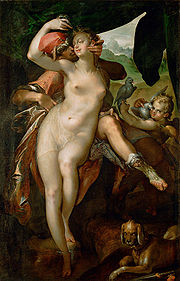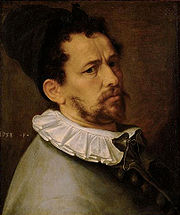
Bartholomeus Spranger
Encyclopedia


Flanders
Flanders is the community of the Flemings but also one of the institutions in Belgium, and a geographical region located in parts of present-day Belgium, France and the Netherlands. "Flanders" can also refer to the northern part of Belgium that contains Brussels, Bruges, Ghent and Antwerp...
Northern Mannerist
Northern Mannerism
Northern Mannerism is the term in European art history for the versions of Mannerism practiced in the visual arts north of the Alps in the 16th and early 17th century...
painter, draughtsman
Drawing
Drawing is a form of visual art that makes use of any number of drawing instruments to mark a two-dimensional medium. Common instruments include graphite pencils, pen and ink, inked brushes, wax color pencils, crayons, charcoal, chalk, pastels, markers, styluses, and various metals .An artist who...
, and etcher. He was born in Antwerp in the Habsburg Netherlands
Habsburg Netherlands
The Habsburg Netherlands was a geo-political entity covering the whole of the Low Countries from 1482 to 1556/1581 and solely the Southern Netherlands from 1581 to 1794...
(strictly in the Duchy of Brabant
Duchy of Brabant
The Duchy of Brabant was a historical region in the Low Countries. Its territory consisted essentially of the three modern-day Belgian provinces of Flemish Brabant, Walloon Brabant and Antwerp, the Brussels-Capital Region and most of the present-day Dutch province of North Brabant.The Flag of...
).
Biography
He is mentioned in Karel van Mander's Schilderboeck. In 1565, after completing his training with Cornelis van DalemCornelis van Dalem
Cornelis van Dalem was a Flemish painter in Antwerp. His father was a wealthy Dutch-born merchant who provided him with a good education in the liberal arts. He remained a merchant for his entire life, painting only as an amateur...
, Jan Mandijn
Jan Mandijn
Jan Mandijn , was a Dutch Renaissance painter.-Biography:According to Van Mander in 1604, he was the teacher of Gillis Mostaert, and he could paint funny scenes like Hieronymus Bosch....
, and Frans Mostaert
Frans Mostaert
-Biography:According to Karel van Mander he was the son of a common painter, the twin brother of the painter Gillis Mostaert and the grandson of the painter Jan Mostaert. Gillis looked so much like him that their own father couldn't tell them apart. Both brothers joined the Antwerp Guild of St....
, he traveled to Paris
Paris
Paris is the capital and largest city in France, situated on the river Seine, in northern France, at the heart of the Île-de-France region...
and Italy
Italy
Italy , officially the Italian Republic languages]] under the European Charter for Regional or Minority Languages. In each of these, Italy's official name is as follows:;;;;;;;;), is a unitary parliamentary republic in South-Central Europe. To the north it borders France, Switzerland, Austria and...
. He worked on wall paintings in various churches. At Rome
Rome
Rome is the capital of Italy and the country's largest and most populated city and comune, with over 2.7 million residents in . The city is located in the central-western portion of the Italian Peninsula, on the Tiber River within the Lazio region of Italy.Rome's history spans two and a half...
, he became, like El Greco
El Greco
El Greco was a painter, sculptor and architect of the Spanish Renaissance. "El Greco" was a nickname, a reference to his ethnic Greek origin, and the artist normally signed his paintings with his full birth name in Greek letters, Δομήνικος Θεοτοκόπουλος .El Greco was born on Crete, which was at...
, a protege of Giulio Clovio. Pope Pius V
Pope Pius V
Pope Saint Pius V , born Antonio Ghislieri , was Pope from 1566 to 1572 and is a saint of the Catholic Church. He is chiefly notable for his role in the Council of Trent, the Counter-Reformation, and the standardization of the Roman liturgy within the Latin Church...
appointed him court painter
Court painter
A court painter was an artist who painted for the members of a royal or noble family, sometimes on a fixed salary and on an exclusive basis where the artist was not supposed to undertake other work. Especially in the late Middle Ages, they were often given the office of valet de chambre...
in 1570. He was summoned to Vienna
Vienna
Vienna is the capital and largest city of the Republic of Austria and one of the nine states of Austria. Vienna is Austria's primary city, with a population of about 1.723 million , and is by far the largest city in Austria, as well as its cultural, economic, and political centre...
by Maximilian II, Holy Roman Emperor
Maximilian II, Holy Roman Emperor
Maximilian II was king of Bohemia and king of the Romans from 1562, king of Hungary and Croatia from 1563, emperor of the Holy Roman Empire of the German Nation from 1564 until his death...
, who died soon after his arrival in 1576. But his successor Rudolf II
Rudolf II, Holy Roman Emperor
Rudolf II was Holy Roman Emperor , King of Hungary and Croatia , King of Bohemia and Archduke of Austria...
was even more keen to employ him, and in 1581 he was appointed court painter, the court being by then having moved its seat to Prague
Prague
Prague is the capital and largest city of the Czech Republic. Situated in the north-west of the country on the Vltava river, the city is home to about 1.3 million people, while its metropolitan area is estimated to have a population of over 2.3 million...
, where he stayed until his death there in 1611, shortly before Rudolf was deposed. Rudolf arranged a wealthy marriage for him, and his house was a centre for artists in Prague.
Aegidius Sadeler
Aegidius Sadeler
The Sadeler family were the largest, and probably the most successful of the dynasties of Flemish engravers that were dominant in Northern European printmaking in the later 16th and 17th centuries, as both artists and publishers...
, who lived in his house in Prague for some time, and Hendrik Goltzius
Hendrik Goltzius
Hendrik Goltzius , was a Dutch printmaker, draftsman, and painter. He was the leading Dutch engraver of the early Baroque period, or Northern Mannerism, noted for his sophisticated technique and the "exuberance" of his compositions. According to A...
made engravings of his paintings, spreading Spranger's fame around Europe. Spranger's paintings for Rudolf mostly depict mythological nudes in various complex poses, with some connection to the Emperor's esoteric Late-Renaissance philosophical ideas. His paintings are the most characteristic of the final phase of Northern Mannerism; by far the best collection is in Vienna. His drawings have great energy, in a very free technique.

